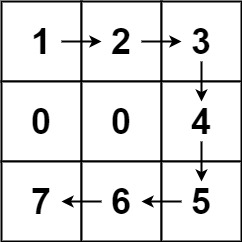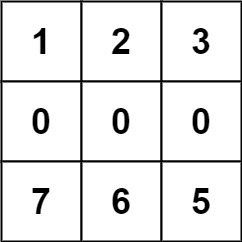![]() LC 675. 为高尔夫比赛砍树
(opens new window) (opens new window)
LC 675. 为高尔夫比赛砍树
(opens new window) (opens new window)
# 问题描述
你被请来给一个要举办高尔夫比赛的树林砍树。树林由一个 m x n 的矩阵表示, 在这个矩阵中:
0表示障碍,无法触碰1表示地面,可以行走- 比
1大的数 表示有树的单元格,可以行走,数值表示树的高度
每一步,你都可以向上、下、左、右四个方向之一移动一个单位,如果你站的地方有一棵树,那么你可以决定是否要砍倒它。
你需要按照树的高度从低向高砍掉所有的树,每砍过一颗树,该单元格的值变为 1(即变为地面)。
你将从 (0, 0) 点开始工作,返回你砍完所有树需要走的最小步数。 如果你无法砍完所有的树,返回 -1 。
可以保证的是,没有两棵树的高度是相同的,并且你至少需要砍倒一棵树。
示例 1:

输入:forest = [[1,2,3],[0,0,4],[7,6,5]]
输出:6
解释:沿着上面的路径,你可以用 6 步,按从最矮到最高的顺序砍掉这些树。
示例 2:

输入:forest = [[1,2,3],[0,0,0],[7,6,5]]
输出:-1
解释:由于中间一行被障碍阻塞,无法访问最下面一行中的树。
示例 3:
输入:forest = [[2,3,4],[0,0,5],[8,7,6]]
输出:6
解释:可以按与示例 1 相同的路径来砍掉所有的树。
(0,0) 位置的树,可以直接砍去,不用算步数。
提示:
m == forest.lengthn == forest[i].length1 <= m, n <= 500 <= forest[i][j] <= 109
# 广度优先搜索
题目需要从矮到高的顺序去砍树,那么我们先遍历一次矩阵,获取到所有树的坐标,然后按树的高度进行排序,然后依次求出相邻两棵树的最短距离。
求相邻两棵树的最短距离我们可以使用广度优先搜索,按层次遍历。用队列 用于记录当层需要走的点,数组 记录已被处理或在队列中待处理的点。我们对队列中的点进行处理,查找它们四个方向上的点,如果相邻的点是在矩阵中,且不是不可达(非),且未被数组 记录,则添加到下一层队列中,直到到找到终点(下一棵树的位置),返回当前步数。若不能到达,则返回 。由于是按层次去遍历的,最先到达终点的步数必然是最少步数,最少步数的和就算整体步数的最少值,最终如果每棵树都能到达,则返回他们步数之和,若某棵树不可达,则返回 。
/**
* @param {number[][]} forest
* @return {number}
*/
var cutOffTree = function (forest) {
const rows = forest.length
const cols = forest[0].length
const dirs = [
[-1, 0],
[1, 0],
[0, -1],
[0, 1]
]
const trees = []
for (let i = 0; i < rows; i++) {
for (let j = 0; j < cols; j++) {
if (forest[i][j] > 1) {
trees.push([i, j])
}
}
}
trees.sort((a, b) => forest[a[0]][a[1]] - forest[b[0]][b[1]])
const bfs = (sx, sy, ex, ey) => {
let step = 0
if (sx === ex && sy === ey) return step
const visited = new Array(rows).fill(0).map(() => new Array(cols))
let queue = [[sx, sy]]
visited[sx][sy] = true
while (queue.length) {
step++
const newQueue = []
for (const [x, y] of queue) {
for (const dir of dirs) {
const nx = x + dir[0]
const ny = y + dir[1]
if (nx === ex && ny === ey) return step
if (nx > -1 && nx < rows && ny > -1 && ny < cols) {
if (forest[nx][ny] !== 0 && !visited[nx][ny]) {
newQueue.push([nx, ny])
visited[nx][ny] = true
}
}
}
}
queue = newQueue
}
return -1
}
let sx = 0
let sy = 0
let ans = 0
for (const tree of trees) {
const step = bfs(sx, sy, tree[0], tree[1])
if (step === -1) return -1
ans += step
;[sx, sy] = tree
}
return ans
}
- 时间复杂度:
- 空间复杂度:
# Dijkstra 算法
也可以使用 算法求相邻两棵树的最短距离。 算法也是利用的广度优先搜索,只是每次对队列中优先选择最短路径的元素。写法上区别并不大,因为相邻节点的距离固定是 1,无需像广度优先搜索构建新的队列,直接入队即可。
没有提供优先队列,但是 提供了 和 ,可以直接使用[1]
/**
* @param {number[][]} forest
* @return {number}
*/
var cutOffTree = function (forest) {
const rows = forest.length
const cols = forest[0].length
const dirs = [
[-1, 0],
[1, 0],
[0, -1],
[0, 1]
]
const trees = []
for (let i = 0; i < rows; i++) {
for (let j = 0; j < cols; j++) {
if (forest[i][j] > 1) {
trees.push([i, j])
}
}
}
trees.sort((a, b) => forest[a[0]][a[1]] - forest[b[0]][b[1]])
const bfs = (sx, sy, ex, ey) => {
if (sx === ex && sy === ey) return 0
const visited = new Array(rows).fill(0).map(() => new Array(cols))
const queue = new MinPriorityQueue({ priority: (i) => i[0] })
queue.enqueue([0, sx, sy])
visited[sx][sy] = true
while (queue.size()) {
const [step, x, y] = queue.dequeue().element
for (const dir of dirs) {
const nx = x + dir[0]
const ny = y + dir[1]
if (nx === ex && ny === ey) return step + 1
if (nx > -1 && nx < rows && ny > -1 && ny < cols) {
if (forest[nx][ny] !== 0 && !visited[nx][ny]) {
queue.enqueue([step + 1, nx, ny])
visited[nx][ny] = true
}
}
}
}
return -1
}
let sx = 0
let sy = 0
let ans = 0
for (const tree of trees) {
const step = bfs(sx, sy, tree[0], tree[1])
if (step === -1) return -1
ans += step
;[sx, sy] = tree
}
return ans
}
- 时间复杂度:
- 空间复杂度:
# A* 启发式搜索算法[2]
算法是另一种路径查找算法,设 的估算函数为 ,其中 表示从起点 (, ) 到 (, ) 的实际距离,评估函数 选择 到 的曼哈顿距离。
与 算法不同, 算法队列中的点已经是与当前节点最近的点,后续在遇到相同节点时,步数不可能更少,因此需要标记,无需再次进队,但 算法队列中的点是预估可能是最近的点,假设我们是要从起点 到终点 ,且当前位于中途点 ,中途点 最少步数的预估包括两部分: 起点 到中途点 的步数 和 从中途点 到 终点 的理论最少步数(曼哈顿距离),起点 到中途点 的步数实际上有可能并非是实际最少步数,如果遇到起点 到中途点 更少的步数时,需要其进行再次入队,才能确保得到最短路径。
/**
* @param {number[][]} forest
* @return {number}
*/
var cutOffTree = function (forest) {
const rows = forest.length
const cols = forest[0].length
const dirs = [
[-1, 0],
[1, 0],
[0, -1],
[0, 1]
]
const trees = []
for (let i = 0; i < rows; i++) {
for (let j = 0; j < cols; j++) {
if (forest[i][j] > 1) {
trees.push([i, j])
}
}
}
trees.sort((a, b) => forest[a[0]][a[1]] - forest[b[0]][b[1]])
const md = (x1, y1, x2, y2) => Math.abs(x1 - x2) + Math.abs(y1 - y2)
const bfs = (sx, sy, ex, ey) => {
if (sx === ex && sy === ey) return 0
const steps = new Array(rows).fill(0).map(() => new Array(cols).fill(-1))
const queue = new MinPriorityQueue({ priority: (i) => i[0] })
queue.enqueue([md(sx, sy, ex, ey), 0, sx, sy])
steps[sx][sy] = 0
while (queue.size()) {
const [_, step, x, y] = queue.dequeue().element
for (const dir of dirs) {
const nx = x + dir[0]
const ny = y + dir[1]
if (nx === ex && ny === ey) return step + 1
if (nx > -1 && nx < rows && ny > -1 && ny < cols) {
if (forest[nx][ny] !== 0) {
if (steps[nx][ny] === -1 || step + 1 < steps[nx][ny]) {
const cost = step + 1 + md(nx, ny, ex, ey)
queue.enqueue([cost, step + 1, nx, ny])
steps[nx][ny] = step + 1
}
}
}
}
}
return -1
}
let sx = 0
let sy = 0
let ans = 0
for (const tree of trees) {
const step = bfs(sx, sy, tree[0], tree[1])
if (step === -1) return -1
ans += step
;[sx, sy] = tree
}
return ans
}
- 时间复杂度:启发式搜索不讨论空复杂度
- 空间复杂度:启发式搜索不讨论空复杂度
本博客所有文章除特别声明外,均采用 CC BY-SA 4.0 协议 , 转载请注明出处!